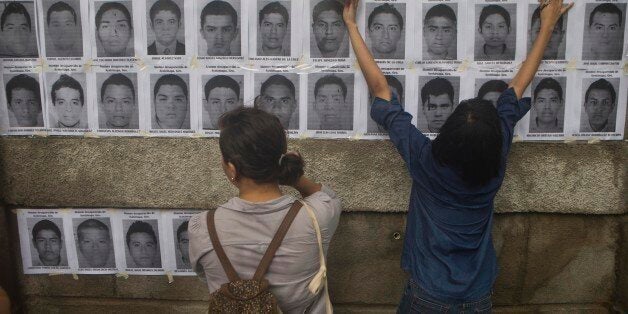
Every week, we bring you one overlooked aspect of the stories that made news in recent days. Have you noticed the media forgetting all about another story's basic facts? Tweet @TheWorldPost or let us know on our Facebook page.
On Sept. 26, dozens of students at a Mexican teachers' college went missing after a protest in the city of Iguala. They were last seen being hauled off into police vans and haven't been heard from since.
While searching for the missing students, investigators have uncovered a string of mass graves, police working for drug cartels and government officials at the helm of criminal operations.
While overall violence in Mexico has decreased in recent years, the current investigation has once again put the spotlight on the ruthless force of the drug cartels, brutal behavior by state security forces, and rampant corruption that are haunting parts of the country. Here are 11 numbers that will help you understand the security situation in Mexico.
The number of students missing since the Iguala protest in September. According to witnesses, the students were heading out of the city when several groups came under fire by police and masked gunmen. By the night's end, six people had been shot dead. The body of one student was later found with his face skinned and his eyes gouged out. Dozens of young men were seen being hauled off into police vans. No one has seen them since.
The number of clandestine graves found near Iguala in the search for the missing students. The remains that have been identified through DNA tests so far have not belonged to the missing students. The results of additional DNA tests are still pending.
The total number of people estimated to have been killed since the the administration of former President Felipe Calderón launched its war on the drug cartels.
The International Crisis Group explains that drug cartel violence in Mexico began to escalate in 2004, under former President Vincente Fox. After assuming office in 2006, Calderón launched a massive crackdown against the criminal organizations, relying in large part on the army. While security forces seized record amounts of drugs and were able to capture or kill dozens of cartel bosses, the offensive came at a price.
Violence between rival cartels and the security forces lead to years of intense bloodshed. The security forces' brutal tactics compromised their legitimacy. And while the aggressive action made it harder for cartels to make money from the drug trade, it also fostered the growth of smaller criminal groups that relied on criminal activities other than smuggling drugs, such as kidnappings and extortion.
Calderón's successor, current President Enrique Peña Nieto, vowed at the start of his presidency to reverse Calderón's approach and reduce the role of the military in the fight against the cartels.
The number of people reported missing or disappeared from the start of Peña Nieto's administration in late 2012 until May 2014, according to Mexico's Interior Minister Osorio Chong. The official later clarified that the actual number of “people not found” topped 22,000, a list that includes people who were reported missing during both the Calderón and Peña Nieto administrations.
The number of homicides in the country reported in 2013, according to Mexico's National Statistics Institute (Inegi). Inegi reports that the main cause of deaths was firearms, followed by knives and strangling. The data do not specify how many of the cases were related to organized crime.
The 2013 rate, which is equivalent to about 19 homicides per 100,000 residents, is a significant drop from the number of cases at the height of the war on the cartels, when rates spiked to 23 homicides per 100,000. The investigative journalism group InSight Crime points out, however, that the statistics don’t include bodies that were never found.
By comparison, the 2012 murder rate in the United States was 4.7 per 100,000 people. The highest national murder rate in 2012 was recorded in Honduras, with 90.4 homicides per 100,000.
The estimated number of households from which at least one member was the victim of a crime in 2013, according to a self-reported survey conducted earlier this year by Mexico's National Statistics Agency. The number is equivalent to nearly 40 percent of Mexican households.
InSight Crime notes that the survey numbers are far higher than Mexico’s official crime statistics, suggesting that a large number of offenses may go unreported. The group calculates that according to the data, 90 percent of crimes were never reported in 2013.
The discrepancy between reported crimes and the "cifra negra" -- the number of crimes that go unreported -- is especially pronounced when it comes to kidnappings, InSight Crime adds. While the study indicates 120,000 people were estimated to have been the victim of kidnapping in 2013, only 1,698 cases were reported.
The number of reported kidnappings in 2013, which is up 15 percent from the year before. The number of kidnappings has grown every year since Calderón launched his massive crackdown on the cartels.
The number of women murdered in Mexico in 2012. Reuters notes that the number rose 155 percent between 2007 and 2012. In northeastern Mexico, the rate jumped by an even higher 500 percent between 2001 and 2010. The most dangerous state for women in 2012 was Chihuahua, with 22.7 murders for every 100,000 female residents.
The number of migrants estimated to have been killed in the past six years due to organized crime while crossing Mexico on their way to the United States. This figure, compiled by the Institute for Women in Migration, includes both Central Americans and Mexicans. According to the National Commission for Human Rights, at least 70,000 migrants disappeared in Mexico between 2007 and 2012.
The rise in the number of reported cases of torture at the hands of Mexico's police or armed forces in the past decade. Amnesty International reports that more than 1,500 people filed a complaint about torture or ill-treatment by authorities in 2013, a 600 percent rise from the number of complaints in 2003. The complaints included accusations of beatings, death threats, sexual violence, electric shocks and near-asphyxiation. A separate Amnesty survey found that 64 percent of Mexicans are afraid they would be tortured by authorities if they were to be detained.
The number of torturers convicted in Mexico's federal courts, according to Amnesty. The group notes that according to Mexico's Federal Judicial Council, federal courts dealt with 123 prosecutions for torture between 2005 and 2013. Just seven of those cases resulted in convictions under federal law.
More From The WorldPost On The Search For The Missing Students:
- Mexico Is Looking For 43 Missing Students. What Has Been Found Is Truly Terrifying- On The Blog: Enough! Mexico Is Ready To Explode
